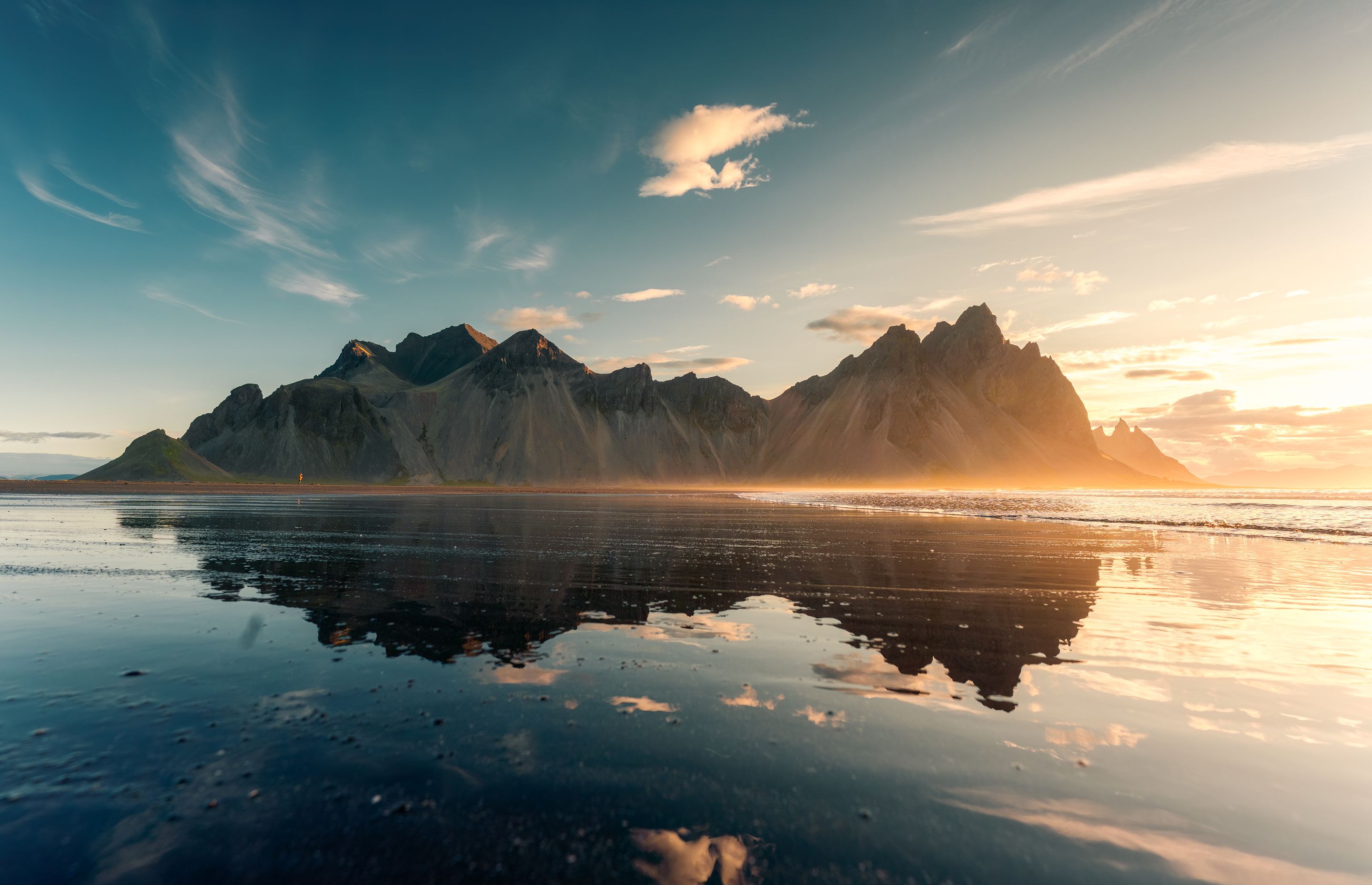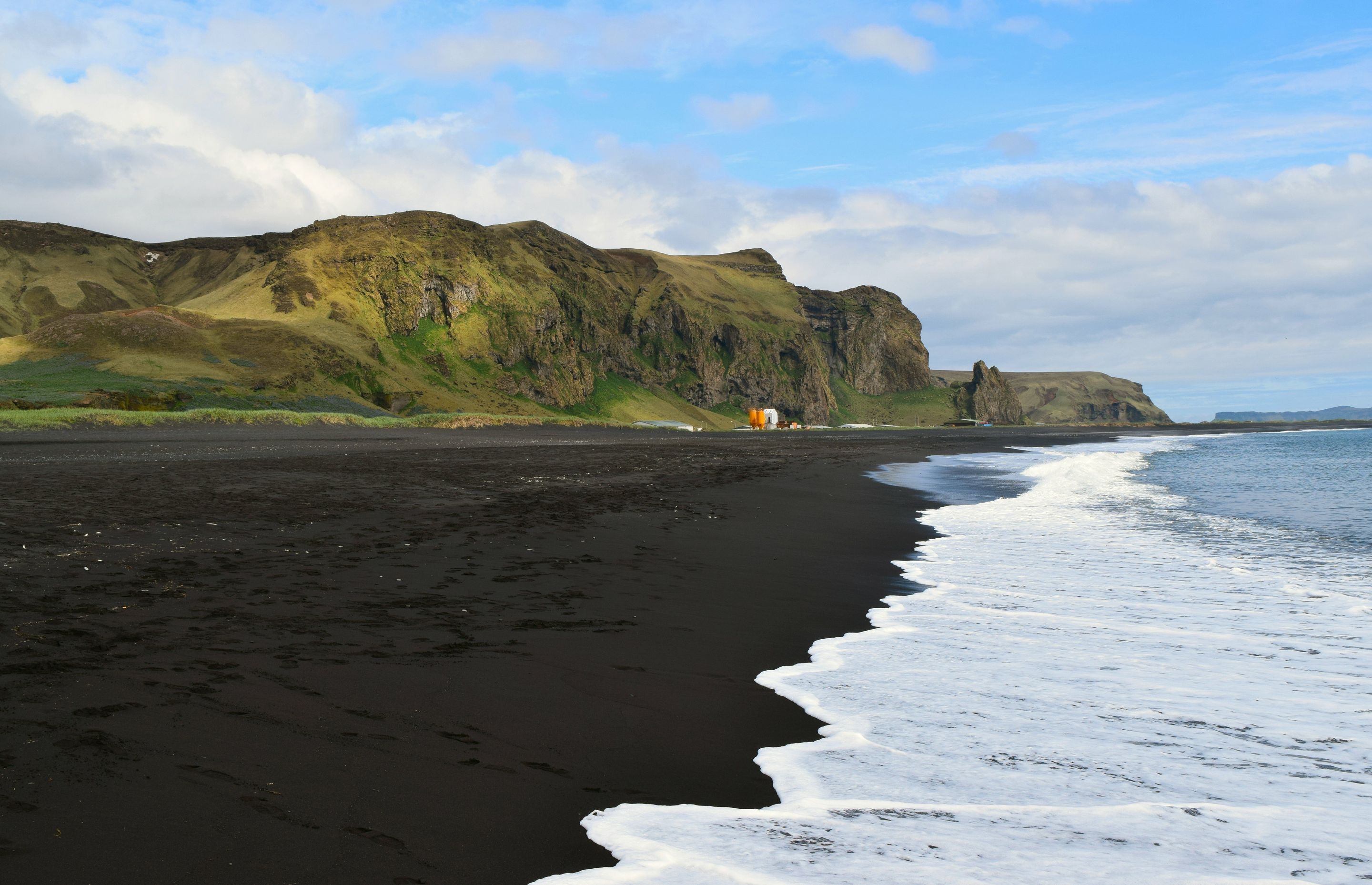
Reynisfjara: The Most Famous Beach in Iceland
Jump to chapter
Iceland’s South Coast is full of amazing sights, but Reynisfjara Black Sand Beach is truly one of a kind. The jet-black sand, towering basalt columns, and dramatic sea stacks create a view you won’t forget. It’s a must-see for anyone visiting Iceland—but be careful, as the waves here can be very dangerous.
What’s Reynisfjara Black Sand Beach?
Reynisfjara Black Sand Beach is a famous spot near the village of Vík í Mýrdal on Iceland’s South Coast. Its black sand comes from cooled lava, its basalt columns are shaped by hardening lava, and the Reynisdrangar sea stacks are tied to old legends that add a magical feel to the area.
The black sand is a result of Iceland’s volcanic activity. When hot lava hit the cold Atlantic Ocean, it cooled so quickly that it broke into tiny pieces. Over time, these pieces turned into the fine black sand you see today. The basalt columns formed when lava cooled and cracked into neat shapes.
Local stories make the Reynisdrangar sea stacks even more fascinating. One legend says trolls were trying to pull a ship ashore but turned to stone when the sun rose. Another story tells of a man who turned trolls into stone to save his wife. I don’t know about you, but I love these kind of stories. For me, they really add a cool touch to the place.

Is It Worth Visiting?
Definitely. Reynisfjara is where nature’s power and beauty come together. Its unique look has made it the most prolific filming location in Iceland. Shows and movies like Game of Thrones, Star Wars: Rogue One, and Star Trek: Into Darkness were filmed there. The black sand, tall basalt columns, and Reynisdrangar sea stacks rising from the ocean create an out-of-this-world experience.
But the beach is more than its Hollywood fame. The crashing waves, changing skies, and stunning views make it 100% unique. Whether you love movies, photography, or exploring amazing landscapes, Reynisfjara will leave you in awe.
In fact, recently released data from the Icelandic government shows that Reynisfjara was the 4th most-visited spot in the country in 2024, with 445,355 visitors. Last but not least, there's a small restaurant close to the beach called Black Beach Restaurant, which is spectacular. It serves amazing soups and has a tasty menu.

Where’s Reynisfjara & How to Get There?
Reynisfjara is about 187 kilometers (116 miles) southeast of Reykjavík, which is around a 2.5-hour drive along Iceland’s Ring Road (Route 1). From the Ring Road, take Road 215, which leads straight to the beach’s parking lot. Whether you’re driving yourself or joining a guided tour of the South Coast, getting to Reynisfjara is pretty straightforward. The drive is beautiful, with views of green fields, jagged mountains, and changing landscapes.
From the parking lot, it’s just a 0.8-mile walk to the beach. The path is paved and very easy to walk, suitable for all fitness levels. You will be able to read educational picture boards along the way, which explain the beach and the history behind it.
The Dangers of Reynisfjara
Reynisfjara is beautiful, but it’s also known for its dangerous sneaker waves. These waves can come out of nowhere, rushing far up the beach and pulling people into the ocean. Sadly, several accidents have happened over the years, with at least six fatalities reported between 2007 and 2024. Yes, it’s that dangerous. Just don’t get close to the water and never turn your back to the sea, and you’ll be fine.
Safety Tips
- Stay back from the water; don’t stand too close to the shoreline.
- Always pay attention and never turn your back on the ocean; sneaker waves can appear suddenly.
- Follow all posted signs and warnings, as they are updated regularly based on wave conditions.
- Don’t swim here; the water is very cold, and the currents are extremely strong.
There are no lifeguards, so you can only rely on your sense of responsibility. I’ve seen locals scream at tourists who get too close to the shore, but you can’t always count on it.
Sneaker Waves
Sneaker waves are big, powerful waves that can come without warning and rush far up the beach. The danger comes from how the beach is shaped. The ocean becomes deep very close to the shore, so the waves stay strong when they hit the beach. The steep slope of the sand makes the water pull back harder, creating strong currents that can knock people over and pull them into the sea. These waves are unpredictable and very dangerous, so always stay far from the water.

Best Time to Visit Reynisfjara
Reynisfjara is beautiful any time of year, but the season you visit can make a big difference. Summer is the busiest season, with an average of 56.000 people visiting the beach every month from June to August.
- Summer (June–August): The Midnight Sun gives you long daylight hours, making it easy to explore the beach and nearby spots. Puffins often nest on the cliffs during this time, so keep an eye out.
- Winter (November–March): The snow against the black sand is stunning, and there’s a chance you’ll see the Northern Lights. Just remember the roads might be icy, and daylight is shorter.
- Sunrise & Sunset: These times are perfect for photos. The colorful skies reflecting on the black sand make for amazing shots.
If you want to see the nearby Hálsanefshellir Cave, plan your visit during low tide. At high tide, the cave can be underwater and hard to reach, so check the tide schedule before you go.

What to Wear When Visiting Reynisfjara
The weather in Iceland changes fast, and it can feel even more unpredictable on the coast. Here’s what to bring:
- Layered Clothing: The temperature can change quickly, so wear layers you can add or remove.
- Waterproof & Windproof Outerwear: A solid rain jacket or windbreaker will keep you dry and protect you from strong winds.
- Sturdy Footwear: The beach can be slippery, so waterproof boots or shoes with good grip are a must.
- Accessories: Even in summer, bring a hat, gloves, and maybe a scarf because the wind can be cold.
Always check the weather forecast before your trip. And don’t forget your camera to capture the incredible views.

Things to Do There & Around
Reynisfjara isn’t just a quick photo stop—you can easily spend a whole day exploring and enjoying the area.
Marvel at the Basalt Columns
Take some time to check out the hexagonal basalt columns along the cliffside. They’re great for photos, and some visitors even climb a few steps (carefully) to get a better look at the waves.

Visit Hálsanefshellir Cave
Next to the basalt columns, you’ll find Hálsanefshellir Cave, which has the same cool geometric rock formations inside. If the tide is low, step inside to see this natural wonder up close.

Capture the Reynisdrangar Sea Stacks
You can’t visit Reynisfjara without admiring the Reynisdrangar sea stacks. Whether you’re interested in the legends or just the dramatic scenery, these towering formations are unforgettable.

Birdwatching
The cliffs at Reynisfjara are a nesting spot for birds like Arctic Terns, Guillemots, and puffins during the summer. Bring binoculars or a zoom lens if you want to get a closer look.

Explore Vík í Mýrdal
A short drive from Reynisfjara, the village of Vík is full of things to do. It's a great place to grab a meal, shop for wool sweaters, or enjoy the beautiful views of the mountains and coastline.

Check Out Dyrhólaey
Close to Reynisfjara, Dyrhólaey is a small promontory with an incredible rock arch and amazing views of the South Coast. On a clear day, you can even spot the Mýrdalsjökull glacier in the distance.

Conclusion
Reynisfjara Black Sand Beach is a stunning example of Iceland’s volcanic history and the power of nature. With its black sand, tall basalt columns, and the famous Reynisdrangar sea stacks, the beach is full of natural beauty—and hidden dangers. By planning your visit, dressing for the weather, and being careful near the ocean, you can enjoy one of Iceland’s most amazing places. Whether you stop by for photos or spend the whole day exploring, Reynisfjara will be a highlight of your trip to Iceland.



